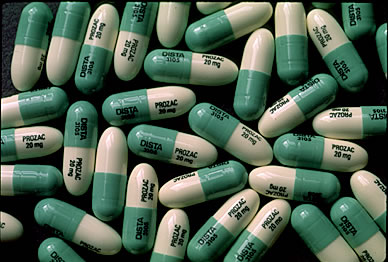Cardiovascular Fitness At Age 18 Predicts Later Risk Of Depression In Men
 Research has connected cardiovascular fitness with depression risk and treatment. A Swedish study published last year in the British Journal of Psychiatry examined records of men conscripted into the military at age 18 and compared their cardiovascular fitness at the time with hospital records from later decades. Low cardiovascular fitness at the time of conscription was associated with increased risk for serious depression.
Research has connected cardiovascular fitness with depression risk and treatment. A Swedish study published last year in the British Journal of Psychiatry examined records of men conscripted into the military at age 18 and compared their cardiovascular fitness at the time with hospital records from later decades. Low cardiovascular fitness at the time of conscription was associated with increased risk for serious depression.
Editor’s Note: This study provides more evidence that exercise, which increases cardiovascular fitness and decreases many of the elements of the metabolic syndrome, is good for cardiovascular and neuropsychological health, including mood stability. It is noteworthy that exercise also increases both brain-derived neurotrophic factor or BDNF (important for neural development and long-term memory) and neurogenesis (in animals), effects shared by almost all treatments with antidepressant properties. Making exercise a routine part of a regimen aimed at medical and psychiatric health is a great idea.
Adolescent Obesity Connected to Brain Impairment
As childhood obesity has increased over the past several decades, the metabolic syndrome has also become more prevalent among children and adolescents. The metabolic syndrome consists of five measures related to obesity: elevations in fasting glucose levels or insulin resistance, a high proportion of LDL (“bad” cholesterol) to HDL (“good” cholesterol), elevated triglycerides, hypertension, and abdominal obesity or high waist circumference. A patient with three of these abnormalities would be diagnosed with the metabolic syndrome.
In adults, the metabolic syndrome has been associated with neurocognitive impairments. Researchers decided to look at adolescents with the metabolic syndrome to determine whether these brain effects are a result of long-term metabolic impairment or whether they can take place after short-term periods of poor metabolism as well. In a study published by Yau et al. in the journal Pediatrics last year, 49 adolescents with the metabolic syndrome were compared to 62 adolescents without the syndrome who had been matched for similar age, socioeconomic status, school grade, gender, and ethnicity.
The adolescents with the metabolic syndrome had lower scores on tests of math, spelling, attention, and mental flexibility, as well as a trend for lower overall intelligence. In brain measures such as hippocampal volume, amount of brain cerebrospinal fluid, and microstructural integrity in white matter tracts, the seriousness of the metabolic syndrome correlated with the level of abnormality on these measures.
Editor’s Note: It seems as though even short-term problems with metabolism can lead to brain impairments like lower cognitive performance and decreased integrity of brain structures. These effects are even seen before vascular disease and type 2 diabetes are manifest.
It is doubly important, in terms of both cardiovascular and neurobiological risks, to look out for one’s medical and psychiatric health. Reducing the abnormal components of the metabolic syndrome should produce benefits for both the cardiovascular system and the central nervous system.
Almost 40% of patients with bipolar illness in the US have the metabolic syndrome, so considerable effort will be required to improve this public health crisis.
Exercise Helps Residual Depression
Many patients with depression require two or more treatments in order to achieve remission. In a 2011 study by Trivedi et al. published in the Journal of Clinical Psychiatry, patients with major depressive disorder who had not responded adequately to selective serotonin reuptake inhibitor (SSRI) antidepressants improved when an exercise regimen was added to their regular treatment.
The patients, aged 18-70 years old, were all sedentary at the start of the trial. They were randomized to one of two exercise regimens: a high dose regimen (16 kcal/kg per week, equivalent to walking at about 4 mph for 210 minutes per week) or the low dose (4 kcal/kg per week, equivalent to walking at 3 mph for about 75 minutes per week). Both groups improved significantly by the end of the study. Remission rates (adjusted for differences between groups) were 28.3% for the high dose group and 15.5% for the low dose group.
The rates of improvement with exercise were similar or better to those commonly seen with other augmenting agents such as lithium, T3, buspirone, and atypical antipsychotics, but without side effects and other inconveniences such as blood monitoring.
Other studies have indicated that exercise by itself and in combination with other treatments has efficacy in depression. Exercise can change serotonin and norepinephrine function and can increase brain-derived neurotrophic factor (BDNF), a, and neurogenesis in the hippocampus.
The researchers looked for moderating variables that may have affected the outcomes of various participants. Men, regardless of family history of mental illness, had better remission rates in the high dose group. Women without a family history of mental illness also improved more in the high dose group, while women with a family history of mental illness improved more in the low dose group, though this finding was statistically nonsignificant.
While the researchers observed that those in the high-dose group did exercise more than those in the low-dose group, participants in the high-dose group had more difficulty sticking to their exercise regimen. It may be that even though high doses of exercise offer slightly higher rates of remission, lower doses may be more effective clinically if patients can stick to the low-dose regimen better.
Antiepileptic Drugs for Bipolar Disorder Do Not Increase Risk of Suicidal Behavior
![]() A 30-year observational study published by Andrew Leon and colleagues in the American Journal of Psychiatry has found that anticonvulsants used in epilepsy and for bipolar depression (carbamazepine, lamotrigine, and valproate) do not increase suicidal behavior in bipolar patients.
A 30-year observational study published by Andrew Leon and colleagues in the American Journal of Psychiatry has found that anticonvulsants used in epilepsy and for bipolar depression (carbamazepine, lamotrigine, and valproate) do not increase suicidal behavior in bipolar patients.
Editor’s Note: The FDA gave a warning in 2009 that these anticonvulsants were associated with suicidal ideation. This was based on studies of a mixed group of psychiatry and neurological patients in acute placebo-controlled studies, where suicidal ideation is typically a reason for exclusion from the study. Leon et al. used more powerful longitudinal methods to compare the risk of suicidal ideation in individuals taking and not taking anticonvulsants and found no such increase in suicidal behavior.
This is like the FDA warning for antidepressants and suicide, which was based on data from placebo-controlled clinical trials in acute depression (where suicidal patients are excluded). When investigators used the same longitudinal methods as Leon et al. in the anticonvulsant study, they found that antidepressants actually reduced suicidal behavior by 30%.
The bottom line is that the use of anticonvulsants for bipolar disorder should not be discouraged based on the FDA warning about suicidal ideation in mixed neurological and psychiatric patients. In bipolar patients, anticonvulsants do not increase the risk of suicidal behaviors, i.e. suicidal acts or completed suicides.
Despite the FDA Warning to the Contrary: Antidepressants Do Not Increase Suicidality
In 2007, the FDA began labeling antidepressants with a warning that patients aged 18-24 were at risk for increased suicidality during the first weeks of treatment. New evidence shows antidepressants actually have beneficial effects on suicide risk in adults. A study of all published and unpublished data on the SSRI fluoxetine (Prozac) and the SNRI venlafaxine (Effexor) published in 2012 by Gibbons et al. in the Archives of General Psychiatry showed that these antidepressants substantially reduced suicidal thoughts and behavior in adults and produced no increase in suicidal thoughts or behavior in children and adolescents.
The protective effect on suicidality in adults was mediated by mood, i.e. the patients’ mood improved and they became less suicidal. Children’s mood also improved on the antidepressants, but their risk of suicidal ideation did not change.
Editor’s Note: These are important findings. When the FDA box warning on antidepressants and suicidal ideation appeared, antidepressant treatment of youth decreased without an accompanying increase in psychotherapy, and the actual suicide rate in youth increased.
We now know that childhood-onset depression carries a bigger risk for a poor outcome in adulthood than adult-onset illness. In parallel, greater numbers of depressions are associated with more impairment, disability, cognitive dysfunction, medical comorbidities, treatment resistances, and neurobiological abnormalities.
It is important to treat illness in young people in order to prevent these difficulties, and the suicide warning should not deter the use of antidepressants. Patients should be careful about suicidal ideation in the first several months after starting an antidepressant, as other data suggest that this is a time of slightly increased risk of suicidal thoughts in children and adolescents.
Vitamin D3 has Positive Effects in Depressed Patients on Prozac
A recent study of patients taking fluoxetine (Prozac) for major depression found that adding 1500 IU of vitamin D3 to their treatment regimen improved their response significantly. The article was published in the Australian and New Zealand Journal of Psychiatry.
According to the Mayo Clinic:
The term “vitamin D” refers to several different forms of this vitamin. Two forms are important in humans: ergocalciferol (vitamin D2) and cholecalciferol (vitamin D3). Vitamin D2 is synthesized by plants. Vitamin D3 is synthesized by humans in the skin when it is exposed to ultraviolet B (UVB) rays from sunlight. Foods may be fortified with vitamin D2 or D3.
Editors Note: Here is another augmenting agent that could be considered for the treatment of those with residual depression. While vitamin D has not been studied directly in bipolar depression, we could ask, “Why not try it?” Other nutritional supplements in this category might be folate and N-acetylcysteine.
Vitamin D supplements are definitely indicated for the large percentage of those in the US who are vitamin D deficient. Given the data from this randomized trial, vitamin D3 could be considered in those with normal levels of vitamin D as well.
Folic Acid During Pregnancy May Lower Autism Risk
 A study of 85,000 children in Norway that was recently published in the Journal of the American Medical Association showed that women who took folic acid during pregnancy were 40% less likely to have a child who developed autism.
A study of 85,000 children in Norway that was recently published in the Journal of the American Medical Association showed that women who took folic acid during pregnancy were 40% less likely to have a child who developed autism.
A summary of the research by National Public Radio explained:
Folic acid is the synthetic version of a B vitamin called folate. It’s found naturally in foods such as spinach, black-eyed peas and rice. Public health officials recommend that women who may become pregnant take at least 400 micrograms of folic acid every day to reduce the chance of having a child with spina bifida.
The folic acid’s effect reduced the most severe cases of autism but did not seem to have an effect on the incidence of more mild forms, such as Asperger syndrome. The benefits were seen in those women who had been taking folic acid for 4 weeks before conception and continued to take the supplement during the first 8 weeks of pregnancy.
Patients with Bipolar Depression Have a Higher Mortality Rate, Especially if They Also Have Cardiovascular Disease
In a large longitudinal study of depressed patients in Taiwan that was published in the Journal of Psychiatric Research this year, Chang et al. found that after 10 years, patients with bipolar depression (N=1,542) had significantly higher mortality rate than those with other types of depression (N=17,480). Patients with bipolar depression were twice as likely to have died from suicide or accidental death than were patients who had other types of depression. When cardiovascular disease was also present in both groups, patients with bipolar disorder were also four times more likely to have died from suicide or accidental death than those with other types of depression.
Editor’s Note: These data again emphasize the critical importance of patients with bipolar disorder carefully looking after their medical and cardiovascular health both early on and throughout the entire course of their illness.
Much of the excess medical mortality in bipolar disorder is attributed to cardiovascular disease, and now those with cardiovascular disease also appear more prone to suicide. This should be a call to action to improve the long-term treatment of both bipolar disorder and its common comorbidity, cardiovascular disease.
Get your medical illness treated!
It will improve your health and longevity. Especially treat these signs of the metabolic syndrome, a major risk factor for cardiovascular disease:
- Cholesterol–Increase “good” cholesterol (high-density lipoproteins or HDLs) and lower “bad” cholesterol (low-density lipoproteins or LDLs)
- High Triglycerides–Triglycerides should be below 150 mg/dL
- Blood Pressure–Aim for 130/85 mmHg or lower
- Blood Sugar–Fasting blood sugar (glucose) should stay below 100 mg/dL
- Overweight & Obesity–Keep waist circumference under 40” for men or 35” for women
Exercise is good for all of these!
How Illness Progresses In The Recurrent Affective Disorders
This editor (RM Post) in collaboration with Jacqueline Fleming and Flavio Kapczinski published the article “Neurobiological mechanisms of illness progression in the recurrent affective disorders” in the Journal of Psychiatric Research this year. The article built on several themes about the progression of bipolar illness that had been explored in previous research.
These themes include:
- The likely acceleration of repeated episodes as a function of the number of prior episodes (episode sensitization)
- The increased responsivity of the illness to repeated stressors (stress sensitization)
- The increased behavioral reactivity to repeated use of psychomotor stimulants such as cocaine (stimulant-induced behavioral sensitization)
Not only are these observations well documented in the scientific literature, but recent observations also suggest that each type of sensitization can show cross-sensitization to the other two types. That is, individuals exposed to repeated stressors are more likely both to experience affective illness episodes and to adopt comorbid substance abuse. In a similar way, episodes of an affective disorder and stressors may also be associated with the relapse into drug administration in those who have been abstinent.
In addition to these mechanisms of illness progression in the recurrent affective disorders, the new article reviews the literature showing that the number of affective episodes or the duration of the illness appear to be associated with a variety of other clinical and neurobiological variables.
The number of affective episodes a patient experiences is associated with the degree of cognitive dysfunction present in their bipolar illness, and experiencing more than 4 episodes of unipolar or bipolar depression is a risk factor for dementia in late life. A relative lack of response to most treatments is also correlated with the number of prior episodes, and this holds true for response to naturalistic treatment in general. While most of these data are correlational and the direction of causality cannot be ascertained for certain, it is likely that the number of affective episodes and/or their duration could account for and drive difficulties with treatment and with cognitive function.
If this were the case, one would expect to see a variety of neurobiological correlates with the number of prior episodes or duration of illness, and in the article we summarize those that have been found in unipolar and bipolar disorder. Considerable data indicate that cortical volume and degrees of prefrontal cortical dysfunction can vary as a function of number of prior episodes. There is evidence that increased activity of the amygdala and the nucleus accumbens are also related to episodes or duration of illness. In those with unipolar depression, the volume of the hippocampus is decreased with longer duration of illness. Read more
High Sustained Success Rate With Adjunctive Memantine (Namenda) in Treatment-Resistant Bipolar Disorder
Koukopoulos et al. published a study of the anti-Alzheimer’s drug memantine in the Journal of Affective Disorders in 2012. The study of memantine (10-30mg/day) as an add-on to patients’ regular treatment for highly treatment-resistant bipolar disorder was open (i.e. not blind, randomized or placebo-controlled), but it deserves careful attention for its noteworthy results. Of the 40 patients in the study, who had been severely ill for long periods of time, 72.5% showed a rating of much or very much improved on the Clinical Global Impressions Scale for Bipolar Disorders (CGI-BP) after both 6 months and 12 months. Among rapid cyclers, 68.4% stabilized and remitted on memantine.
Editor’s Note: Memantine is an antagonist of glutamate NMDA receptors and is approved by the Federal Drug Administration (FDA) for the treatment of Alzheimer’s dementia, but not for other indications. Nonetheless, few (if any) drugs have this high a response rate in such a difficult-to-treat population, and the researchers suggest that even based on these preliminary data (which replicate their previous observations), careful clinical trials of memantine in individual patients would be worthy of consideration.
The data are so promising that fast-track development of this drug for FDA approval would be warranted. More formal randomized controlled clinical trials are needed.
We have written before about a few treatments that have rapid-onset antidepressant effects, including intravenous (IV) ketamine (at a dose of 0.5mg over 40 minutes). Ketamine works by blocking glutamate NMDA receptors, but the rapid antidepressant effects it produces (within 2 hours of treatment) last only 3 to 4 days. Given the similar mechanisms of action of ketamine and memantine and memantine’s high success rate in this study by Koukopoulos, it is plausible that treatment with memantine could extend the rapid onset effects of IV ketamine. However, this speculation has not yet been tested. At the very least, the similarity between the mechanisms of memantine and ketamine in blocking the glutamate NMDA receptor lends additional support to the clinical rationale for treating bipolar disorder with adjunctive memantine.








